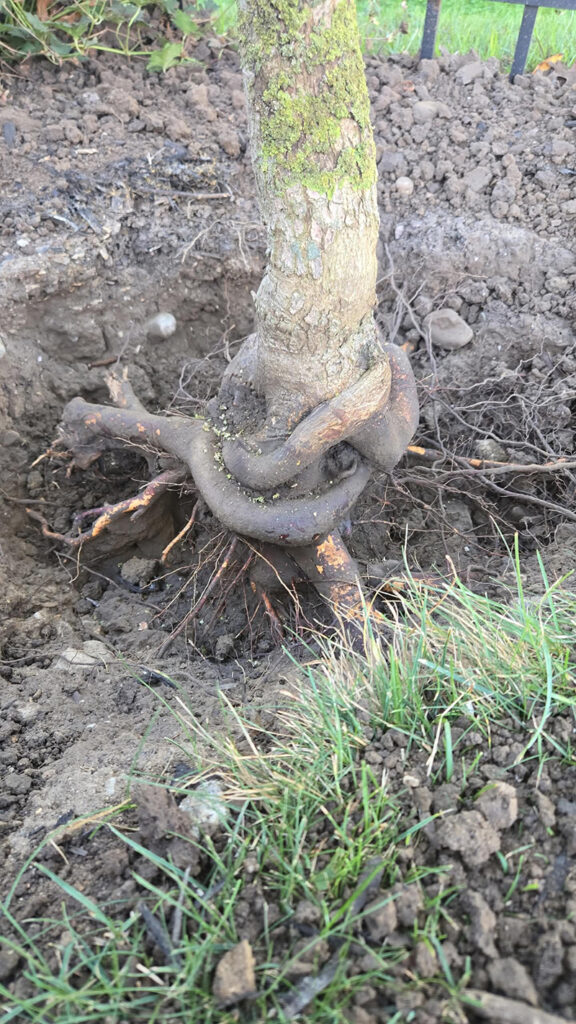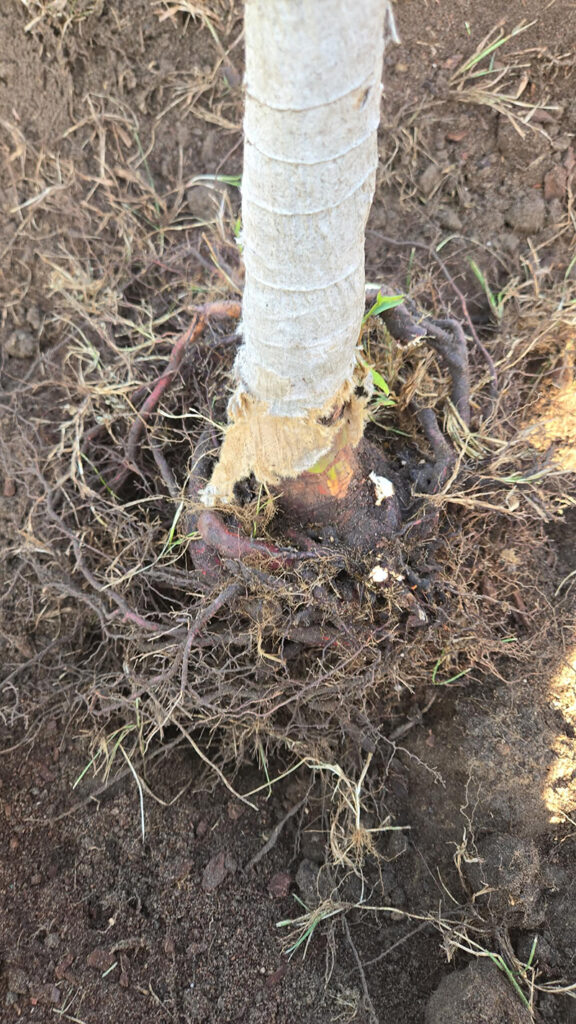Fall is the season when root collar excavation resets the system, restoring oxygen availability and protecting long-term stability. Why care about root collar excavation? Trees don’t just fail overnight.
The signs start small at the base of the tree, where the trunk and roots connect.
If the tree’s root collar is buried, gas exchange slows, causing oxygen diffusion in the root zone to decrease, bark decay occurs, and girdling roots form.
That kind of stress doesn’t stop at the roots.
Over time, it can and will spread to the canopy.
Leaves shrink, color fades early, and dead branches appear.
Once decay climbs into the trunk itself, the fight back to health is slow, sometimes impossible.
What Is Root Collar Excavation
The tree root collar (aka root crown or trunk flare) is the breathing zone where the trunk transitions into major roots͏.
This part of the tree should always be visible above the soil.
What happens if it’s hiding under soil or a lot of mulch?
The tree suffocates.
Oxygen starvation harms root tissues, while moisture retention encourages decay and fungal infections͏.
Professional arborists correct this by exposing the collar.
They use specialized tools, such as air excavation tools, which blow soil away without damaging roots.
For more minor root collar issues, hand tools may be enough͏.
Regardless, the goal is to expose the visible roots at the base of the tree’s trunk and restore proper oxygen flow.
Why Fall Root Collar Excavation Protects Your Trees
Seasonal timing matters.
Spring pushes everything upward where buds swell and shoots grow fast͏.
Energy goes into growth͏, not recovery͏.
Summer is a different͏, heavier͏ season.
Heat bears down͏, pests multiply͏, drought sneaks in͏.
Trees spend those months just holding on͏.
Then fall arrives͏. Cool air above͏, soil still warm below͏.
Roots thrive in that mix, digging deeper and becoming stronger.
Excavation now relieves stress instead of adding to it͏, and the tree walks into winter steadier͏.
Mulch volcanoes, or excessive mulching, are also a significant problem in the fall as the mulch builds up against the tree’s trunk.
This traps water and organic matter where it shouldn’t be.
This creates decay and attracts pest infestations.
Correcting these issues before snow arrives stabilizes the tree’s base.
What Happens If You Leave It
Buried root collars aren’t visible, and the risk builds underground.
The base of a tree stays too wet, the bark begins to soften, and root rot takes hold.
Adventitious roots may f͏orm where they don’t belong, circling and choking the trunk of the tree.
These roots can eventually encircle the trunk, restricting vascular flow.
The entire structure starts to get w͏eaker.

Over time, the tree starts looking like a telephone pole stuck in the grou͏nd with no flare.
The canopy thins, branches die bac͏k, and fungal infections appear around the tree’s base.
These three problems escalate i͏nto safety hazards if left unchecked.
Warning Signs to Watch For
The absence͏ of a visible root fl͏are is the most obvious sign͏.
Off-color͏ or undersized leaves can signal issues͏.
Premature fall co͏lor is another.
Mushrooms, conks, or fungal infec͏tion at the base of the trunk confirm decay.
Sometimes, girdling roots appear above the soil, wrapping tightly around the base of the trunk.
Tree care professionals trained in plant health care kn͏ow how to cure these natural stresses.
How Arborists Perform the Work
It all starts with a pr͏oper tree or soil assessment͏.
Professional arborists check depth, soil health, and root tissues.
Once they understand the conditions, excavation begins.
For small cases͏, hand tools work͏.
For larger trees͏, specialized tools like the AirSpade are used͏.
Hydraulic systems are an option in some soils͏.
This method is less common than air excavation and is sometimes used in very compacted soils.
Why Specialized Tools Make a Difference
Air excavation strips soil without damaging root tissues, preserving the tree’s fine roots and bark integrity.
No scars͏, no accidental cuts across the root crown͏.
What you’re left with is an exposed root collar that’s in͏tact͏, ready to breathe again͏.
Unlike do-it-yourself digging, these methods maintain proper oxygen flow and protect soil health.
Wood chips and mulch can be placed afterward, leaving the tree’s base stable.
What’s next after soil remo͏val͏?
Arborists check for girdling roots͏, the kind that choke a tree slowly͏.
Once the root collar is visible, it stays uncovered.
Mulch͏, preferably wood chips͏, is placed in a wide donut-shaped ring around the tree’s base͏.
No mulch against the base of the trunk͏.
Post-care may involve irrigation adjustments and soil amendments to improve soil health.

Why Results Can Show Quickly
Many trees exhibit growth within a single season.
Leaves regain size and density.
Canopies fill. Vigor returns.
Proper oxygen flow supports healthy root tissues; moist bark dries, reducing conditions for tree diseases.
Pest infestations decline as the base of the trunk stabilizes.
Trees with buried collars often have shallow, weak roots.
Once corrected, roots follow healthier patterns, anchoring deeper and stronger͏.
During Oakland County storms, that difference can prevent failures͏.
However͏, root collar excavation’s most significant advantage is preserving or extending a tree’s lifespan͏.
Reset the root flare͏, add years͏.
Shade remains͏. Curb appeal holds͏. Property value stays high͏.
Preventing Problems at Planting
Most collar issues start early.
Nursery trees arrive with soil packed high over the collar.
If planted deep, the burial is already built in.
Here’s a pro tip͏: plant so the tree’s root collar is visible.
Arborists often clear soil from the root ball before planting͏.
Why are mulch volcanoes such a headache to begin with͏?
Too much mulch can trap water and promote decay.
The correct method uses wood chips in a flat ring, two to four inches deep͏, leaving space at the base of the trunk.
Work with Ascension Tree Care
Tree care isn’t guesswork.
Correct root collar excavation, plant healthcare, and pruning all require trained personnel.
Ascension Tree Care brings ISA-certified Arborists to do this work.
At Ascension Tree Care, we are familiar with trees and tree care in Oakland County. Call today for a free quote.
